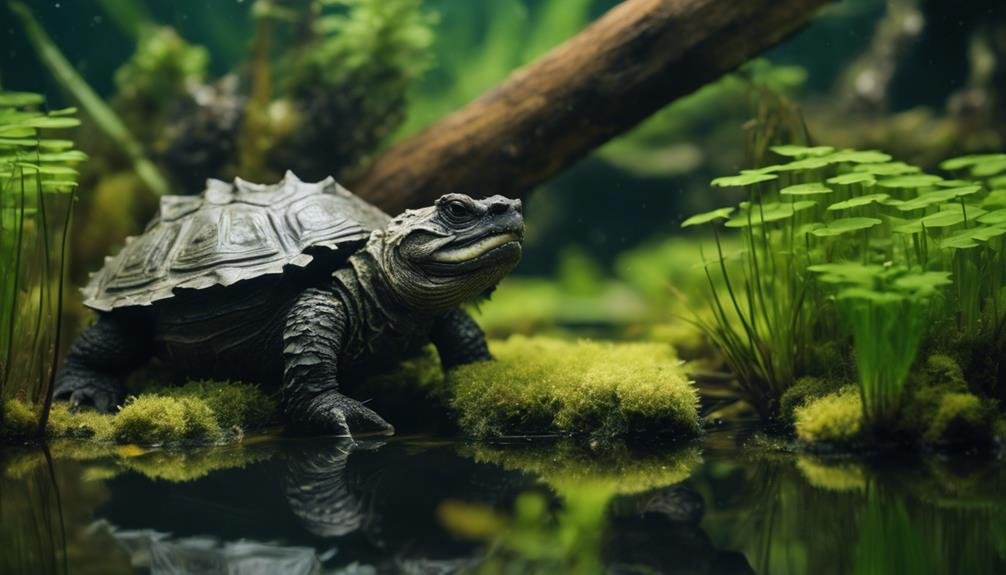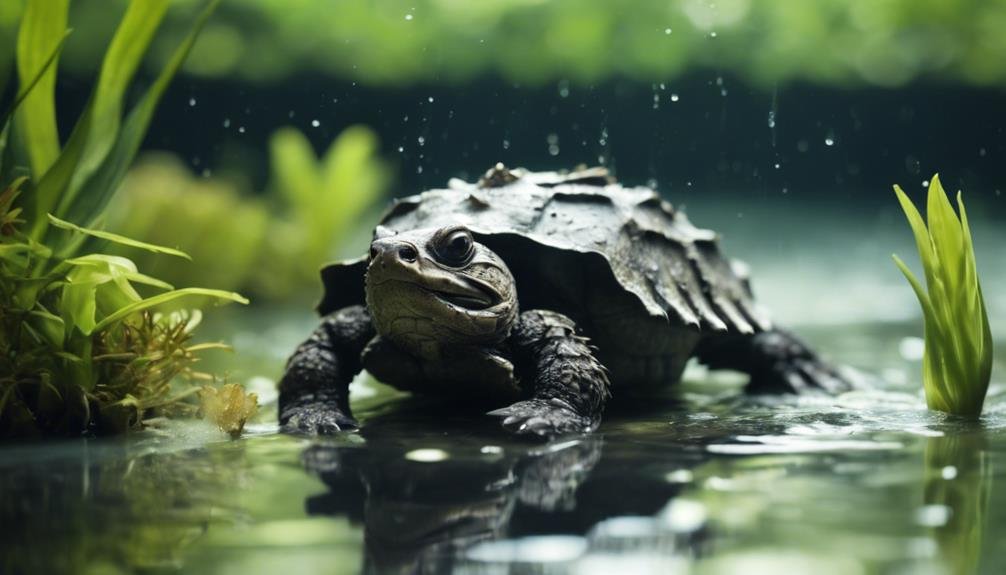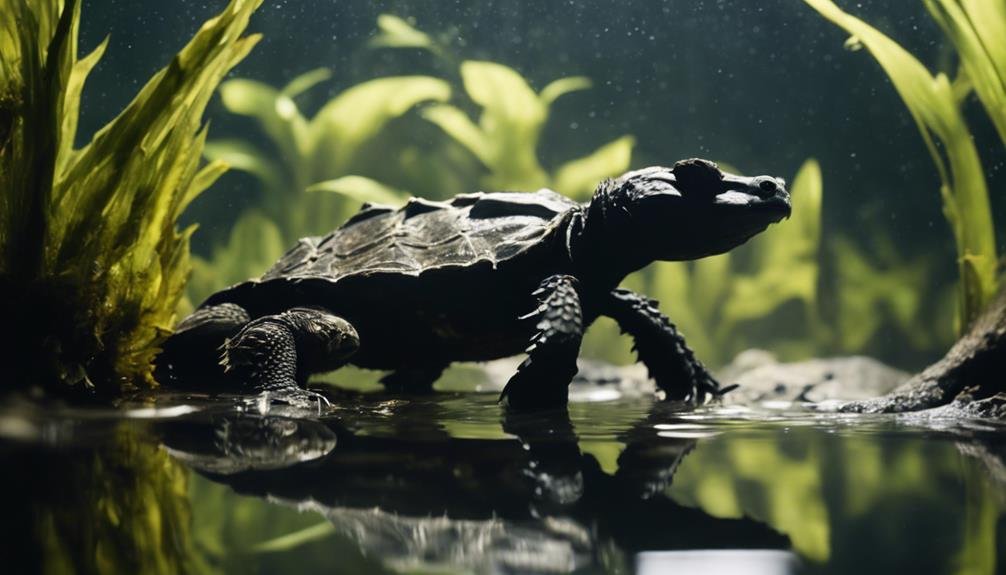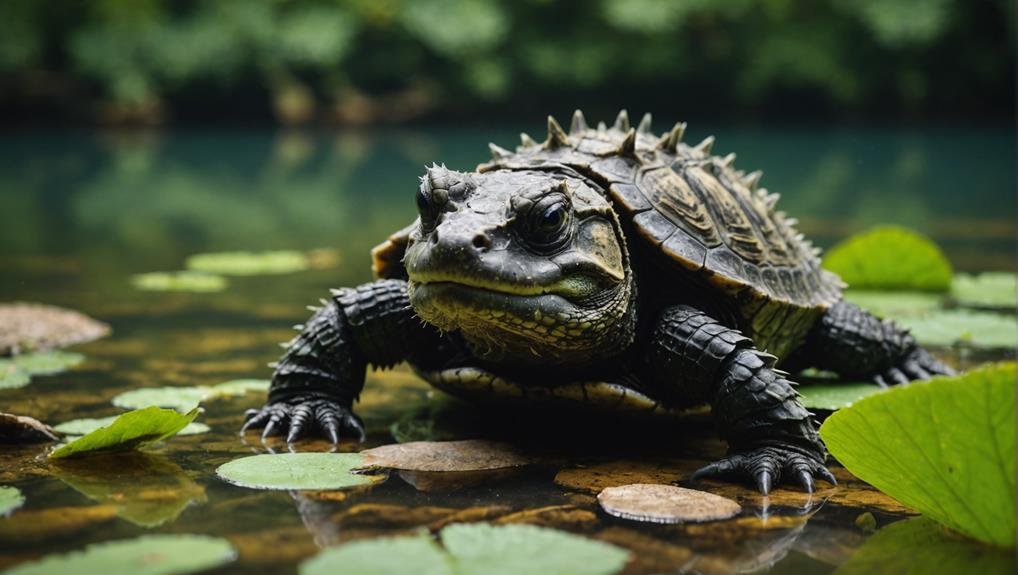You might find baby alligator snapping turtles fascinating due to their unique appearance and behavior. With rugged shells adorned with spikes and a powerful bite, these tiny creatures, measuring about four inches at birth, exhibit a surprising level of aggression and survival instinct. Their dark, muddy skin allows them to blend seamlessly into their aquatic environments, making them effective hunters from an early age. But how do they navigate the challenges of their habitats, and what threats do they face as they grow? Understanding these aspects sheds light on their intriguing world.
Key Takeaways
- Baby alligator snapping turtles have rugged shells with three rows of spikes and measure around four inches at hatching.
- They exhibit strong, aggressive characteristics from a young age, using powerful jaws to snap down on prey.
- They primarily eat fish, invertebrates, amphibians, and small mammals, with daily feeding supporting rapid growth.
- They prefer slow-moving water with abundant vegetation and thrive in southern U.S. waterways, such as rivers, lakes, and swamps.
- Conservation efforts are crucial due to habitat destruction, pollution, and overharvesting threats, with the species listed as Vulnerable.
Habitat and Distribution


Alligator snapping turtles thrive in the deep waterways of the southern United States, including large rivers, canals, lakes, bayous, and swamps. Their habitat is primarily in Louisiana, Texas, Mississippi, and Florida. These turtles prefer environments with slow-moving water and abundant vegetation, which provide ample cover and hunting opportunities.
The distribution of alligator snapping turtles is largely limited to these southern regions due to their specific habitat requirements. They need deep, calm waters to support their unique hunting techniques and lifestyle. They use Peckhamian mimicry in these habitats, employing a small pink vermiform tongue to lure unsuspecting prey directly into their powerful jaws.
As a vulnerable species listed by the IUCN, the preservation of its habitat is essential for its survival. Human activities such as water pollution, habitat destruction, and unregulated hunting have greatly impacted its distribution.
Physical Characteristics
Baby alligator snapping turtles boast a unique appearance characterized by a rugged shell with three prominent rows of spikes. These spikes give them a prehistoric look, making them easily distinguishable from other turtles. When they hatch, their shells are typically around four inches long. Despite their small size, they already exhibit the strong and aggressive characteristics of adult alligator snapping turtles.
Their jaws are incredibly powerful for their size, capable of snapping down with impressive force. This jaw strength, combined with their spiked shells, makes them formidable from a young age. Their skin is often dark and muddy, blending seamlessly with their natural habitat.
Here’s a quick overview of their physical attributes:
| Attribute | Description | Remarkable Feature |
|---|---|---|
| Shell | Rugged with spikes | Three prominent rows of spikes |
| Size at Hatching | Around four inches | Small but mighty |
| Jaw Strength | Very strong | Capable of snapping forcefully |
| Skin Color | Dark, muddy | Excellent camouflage |
| Lifespan | Over 150 years | Extremely long-lived |
As you can see, these baby turtles are fascinating creatures from birth. Their physical characteristics equip them well for survival in their aquatic environments.
Diet and Feeding Behavior


You’ll want to understand their natural food sources and hunting techniques when feeding your baby alligator snapping turtle. These turtles primarily eat fish, insects, and small mammals, using their unique tongue as a lure.
Make sure to offer a varied diet and monitor feeding frequency to keep them healthy and active.
Natural Food Sources
Primarily carnivorous, alligator snapping turtles rely on a varied diet, including fish, invertebrates, amphibians, and small mammals. As an alligator snapping turtle owner or enthusiast, you’ll find that these creatures are quite opportunistic feeders. In their natural habitat, they use their keen sense of smell to locate diverse food sources underwater.
Here’s a breakdown of their primary food sources:
- Fish: Alligator snapping turtles consume various fish species, providing essential nutrients for growth and development.
- Invertebrates: They also feed on invertebrates like crayfish, snails, and insects, adding a crunchy texture to their diet.
- Amphibians and Small Mammals: Frogs, tadpoles, and even small rodents can become part of their meals, offering a protein-rich diet.
These turtles can also scavenge, consuming carrion when available. This scavenging behavior helps them survive in environments where live prey might be scarce. It’s fascinating to observe their adaptability, making the most of whatever food sources they encounter.
Hunting and Foraging
With their stealthy ambush tactics, alligator snapping turtles lie motionless underwater, their mouths open to lure unsuspecting prey with their worm-like tongues. This unique feeding strategy allows them to attract fish, amphibians, and invertebrates into their powerful jaws. When an unsuspecting victim approaches, the turtle swiftly shuts its mouth, capturing its meal remarkably.
Your baby alligator snapping turtle uses these hunting techniques primarily at night, relying on patience and precision. Their sharp beak helps them consume prey quickly and effectively, making them formidable predators despite their small size. Food preferences typically include fish and amphibians, but they’re opportunistic feeders, so they’ll also eat small mammals, carrion, and some plant material.
Baby alligator snapping turtles’ foraging behavior doesn’t just involve ambush tactics. They’ll also scavenge for food, showcasing diverse feeding habits. Their diets can be quite varied, which helps them thrive in different environments.
Feeding Frequency
Feeding your baby alligator snapping turtle daily supports its rapid growth and development. These turtles have a high growth rate when young and need a consistent feeding schedule. A varied diet that meets their nutritional requirements is important.
Here’s a simple guide to help you out:
- Daily Feeding Schedule: Feed your baby turtle every day. Their diet should include aquatic plants, fish, insects, and small mammals to ensure they get a balanced intake of nutrients.
- Nutritional Requirements and Meal Variety: Mix their meals to cover all their dietary needs. Variety is essential because it helps prevent deficiencies and keeps your turtle healthy and energetic.
- Monitoring Feeding Habits: Monitor how much and how quickly your turtle eats. This will help you make necessary dietary adjustments as it grows.
As your turtle ages, you can reduce the feeding frequency several times a week, matching its slower growth rate. Paying attention to its feeding habits and making appropriate dietary adjustments will ensure it thrives.
Growth and Development
You’ll notice significant changes in baby alligator snapping turtles during their early life stages. They grow rapidly, reaching around 10 inches in shell length within a few years.
Monitoring their shell and size changes regularly helps guarantee they’re developing healthily.
Early Life Stages
Baby alligator snapping turtles, measuring just a few inches at hatching, undergo rapid growth and development in their early life stages. These tiny creatures emerge from eggs in carefully selected nesting sites, where environmental conditions and predator presence often influence the survival rates.
Unlike many animals, alligator snapping turtles exhibit no parental care. Once the eggs are laid, the female leaves and the hatchlings are left to fend for themselves, developing their survival instincts early on.
Understanding their early life stages can be broken down into a few key aspects:
- Nesting habits and survival rates: Female turtles lay their eggs in sandy or muddy areas, often near water. The survival rates of baby turtles depend greatly on the nest’s location and the presence of predators.
- Parental care and social behavior: No parental involvement after laying eggs. Hatchlings are solitary from birth and must rely on their instincts to survive.
- Reproduction and mating rituals: The mating rituals of adult alligator snapping turtles are essential for the species’ continuation. Females usually lay eggs once a year, which then hatch into these tiny, vulnerable reptiles.
Shell and Size Changes
As alligator snapping turtles grow, their shells and body size undergo significant and fascinating changes. Initially, hatchlings start with a shell length of 15-26 inches, but you’ll notice substantial shell growth as they mature. These turtles’ shells can eventually reach up to 31.5 inches in length, which is quite impressive.
Weight changes also play an important role in their development. Males typically weigh between 25 and 75 lbs, while females can range from 70 to nearly 200 lbs. However, some exceptional individuals have been known to weigh as much as 316 lbs. This considerable size development requires proper care and an appropriate environment to thrive.
As juveniles, they need a 55-gallon or larger enclosure. This space allows for adequate movement and shell growth. When they become adults, they require even larger habitats—200 to 800-gallon setups with deep water and a basking area are ideal.
These turtles can live well past 150 years, so you must be prepared for a long-term commitment. Female alligator snapping turtles might become antsy during the breeding season, indicating their unique behavioral changes and physical growth. Understanding these needs ensures their healthy development throughout their lives.
Predators and Threats


Despite their tough appearance, baby alligator snapping turtles face numerous predators and threats that endanger their survival. Due to their small size and limited mobility, these young turtles face high predation risks. Birds, raccoons, and larger fish are all-natural predators that pose a significant threat. Additionally, environmental hazards such as habitat destruction and pollution further jeopardize their chances of survival.
Their vulnerabilities don’t end there. Human activities, including fishing nets and boat propellers, also pose a serious risk. Baby alligator snapping turtles often face these obstacles, making protective measures vital. Efforts must be made to mitigate these threats and help these young turtles thrive.
Survival challenges are numerous, but ongoing conservation efforts aim to protect these remarkable creatures. By addressing their threats, we can help secure their continued existence.
Here are three main threats they encounter:
- Predators: Birds, raccoons, and larger fish often prey on baby alligator snapping turtles.
- Environmental Hazards: Significant threats include habitat destruction, pollution, and illegal poaching.
- Human Activities: Fishing nets and boat propellers frequently harm these vulnerable turtles.
Conservation efforts are essential for mitigating these risks and securing their survival.
Conservation Status
Recognizing the myriad threats baby alligator snapping turtles face, it’s essential to understand their current conservation status to guarantee their survival. The IUCN lists these turtles as Vulnerable, with declining population trends due to habitat loss, pollution, and overharvesting. Their numbers plummeted in regions where they’re heavily harvested for their meat and shells.
Conservation efforts are underway to protect these unique reptiles. Initiatives like habitat preservation and breeding programs play a significant role. Raising awareness about their ecological importance also helps garner support for their protection. Unfortunately, human impact, particularly illegal poaching and the pet trade, threatens their existence. Legal protection is paramount, but enforcement remains a challenge.
Awareness campaigns and community involvement are essential to bolster conservation efforts. By educating people about the dangers these turtles face and the steps needed to protect them, communities can actively participate in ensuring their survival.
Collaborative research and conservation initiatives aim to study and safeguard baby alligator snapping turtle populations, promoting long-term survival in natural habitats. Your support of these efforts and spreading awareness can make a significant difference in protecting these incredible creatures.
Conclusion
In your journey of understanding baby alligator snapping turtles, you’ve explored their rugged physical characteristics, aggressive feeding behavior, and unique habitats.
You’ve learned how they grow and face various threats in their environment. Despite their small size at birth, they’re equipped with powerful jaws and effective camouflage, ensuring their survival.
Their conservation status reminds us of the importance of protecting these fascinating creatures. By appreciating their role in the ecosystem, we can contribute to their preservation.
FAQs
1. Can You Keep a Baby Alligator Snapping Turtle as a Pet?
You can keep one as a pet, but consider its housing requirements, feeding habits, and lifespan expectations. Guarantee a suitable enclosure, proper diet, and commitment to long-term care as they live for decades.
2. What Do You Do if You Find a Baby Alligator Snapping Turtle?
If you find a baby alligator snapping turtle, don’t handle it without training due to potential dangers. Provide an appropriate habitat with water and food, and contact a wildlife rehabilitation center for proper handling techniques and assistance.
3. How to Tell the Difference Between a Baby Common Snapping Turtle and a Baby Alligator Snapping Turtle?
To tell the difference, check the shell differences: common snapping turtles have smooth shells, while alligator snapping turtles have spiked ones. Common snappers are found in varied habitats, while alligator snappers prefer specific ones.
4. Are Baby Snapping Turtles Aggressive?
Yes, baby snapping turtles can be aggressive, especially when threatened. Their feeding habits, natural predators, and habitat preferences influence this behavior. To minimize aggression, handle them cautiously and provide a stress-free environment.
Related Article
https://thereptileguide.com/chameleon-facts/
https://thereptileguide.com/what-do-iguanas-eat/


